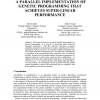500 search results - page 75 / 100 » Humans in the Process: Architectural Implications |
MDM
2005
Springer
14 years 3 months ago
2005
Springer
Sensor networks are promising unprecedented levels of access to information about the physical world, in real time. Many areas of human activity are starting to see the benefits ...
ICMCS
2000
IEEE
14 years 2 months ago
2000
IEEE
In this paper, a non-linear relevance feedback mechanism is proposed for increasing the performance and the reliability of content-based retrieval systems. In particular, the huma...
AAAI
2010
13 years 11 months ago
2010
Understanding conceptual change is an important problem in modeling human cognition and in making integrated AI systems that can learn autonomously. This paper describes a model o...
ISCI
1998
13 years 9 months ago
1998
: This paper describes the successful parallel implementation of genetic programming on a network of processing nodes using the transputer architecture. With this approach, researc...
GECCO
2009
Springer
14 years 4 months ago
2009
Springer
The need for a stopping criterion in MOEA’s is a repeatedly mentioned matter in the domain of MOOP’s, even though it is usually left aside as secondary, while stopping criteri...

